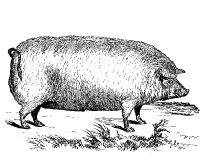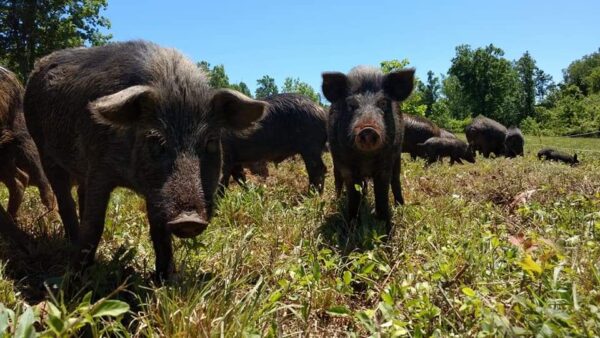
Breed Facts
Status:
Critical
Use:
Meat, Lard/Back Fat
Adult Weight:
Male – 250-300 lbs.
Female – 150-250 lbs.
(varies among lines and in captivity)
Temperament:
Active; docile if handled when young
Experience Level:
Intermediate
Notes:
May be used for Suckling BBQ, Charcuterie, Sausage/Ground
OSSABAW ISLAND
Early explorers brought livestock to the Americas beginning in the 1500s, including pigs that either escaped or were deliberately freed. These pigs were the foundation for the historic populations of swine in the southern United States, one being the Ossabaw, a free-range breed that is found on Ossabaw Island, off the coast of Georgia, near Savannah.
There is historic agreement that Ossabaw Island hogs have descended from foundation stock brought by Spanish explorers, inferring that the pigs are Spanish in origin. However, DNA analysis suggests that the ancestors of the Ossabaw Island pigs were from the Canary Islands, an important stop for the Spanish and Portuguese explorers traveling west.
Mitochondrial DNA (mtDNA), which comes only from the maternal side, showed that Ossabaw Island hogs are more likely related to the Canary Islands pigs that were influenced by Asian pigs. The mtDNA of Spanish (or Iberian) pigs reflects only European influences. Additional genetic research, including that of the paternal DNA side, is needed to understand the relationship of the pigs on the Canary Islands and Ossabaw Island to Spanish pigs.
The Ossabaw hogs are unusual and important as they have adaptations harking back to their history before their re-introduction to domestication. Their history as an isolated island population means that they are the closest genetic representative of historic stocks brought over by the Spanish. Second, the presence of pigs on Ossabaw Island provides scientists with an exceptional opportunity to study a long-term isolated population. Third, the Ossabaw is biologically unique, having been shaped by natural selection in a challenging environment known for heat, humidity, and seasonal scarcity of food.
Due to their adaptation to the island, the breed became smaller over time (“insular dwarfism”). They range in size from 100-200 lbs., but they are able to store astounding amounts of body fat to survive during the seasons when there is little to eat. This biochemical adaptation resembles non-insulin-dependent diabetes in humans, making the pigs a natural animal model for this disease. The pigs are also highly tolerant of dietary salt. Once Ossabaw Island hogs are removed from the selective pressures of their island home, they lose some of their unique survival adaptations. Their ability to fatten is both an advantage and a disadvantage, and breeders must watch their feed intake to prevent obesity.
When first removed from the island, most Ossabaw hogs were black. After many generations in domestication, many are black with white spots or light with black spots. Adult pigs are very hairy with heavy bristles on the head, neck, and topline. The frayed tips of the bristles, a primitive characteristic, is an indication of the distinctiveness of the population. Their snouts are long and slightly dished. The head and shoulders of the hogs are heavy, and while they seem out of proportion to the rest of the body, Ossabaws are quick and agile in the dense undergrowth of the island. True Ossabaws do not produce the striped piglets typical of populations that have had Wild Boar introductions and that have been found in the northern part of the Island.
Although pigs have lived on Ossabaw Island for several centuries, they do have an impact on the island’s ecology, especially on the loggerhead turtle nests. Environmentalists manage the pigs on the island to limit their negative impact on the island’s ecology.
Unfortunately, the last hogs were taken from the Island in 2002. Georgia and South Carolina state authorities are concerned that Ossabaw Island pigs can carry several transmittable diseases including vesicular stomatitis, brucellosis, and pseudorabies, so removal of live pigs from the Island is not permitted. However, Ossabaw Island pigs have been well established in domesticated herds outside of the island since the 1980s.
Ossabaw Island pigs are well suited for sustainable or pastured pork production. Their pork and lard are highly valued by chefs. They begin gestation around six months of age and can produce two litters of 8-12 piglets a year. This unique breed is in need of special stewards who understand and appreciate its history and its need for conservation.
Did you know:
Commercial food production relies on only a handful of livestock and poultry breeds. The biodiversity represented in the breeds protected by The Livestock Conservancy is needed to safeguard the future of agriculture in a changing world.

